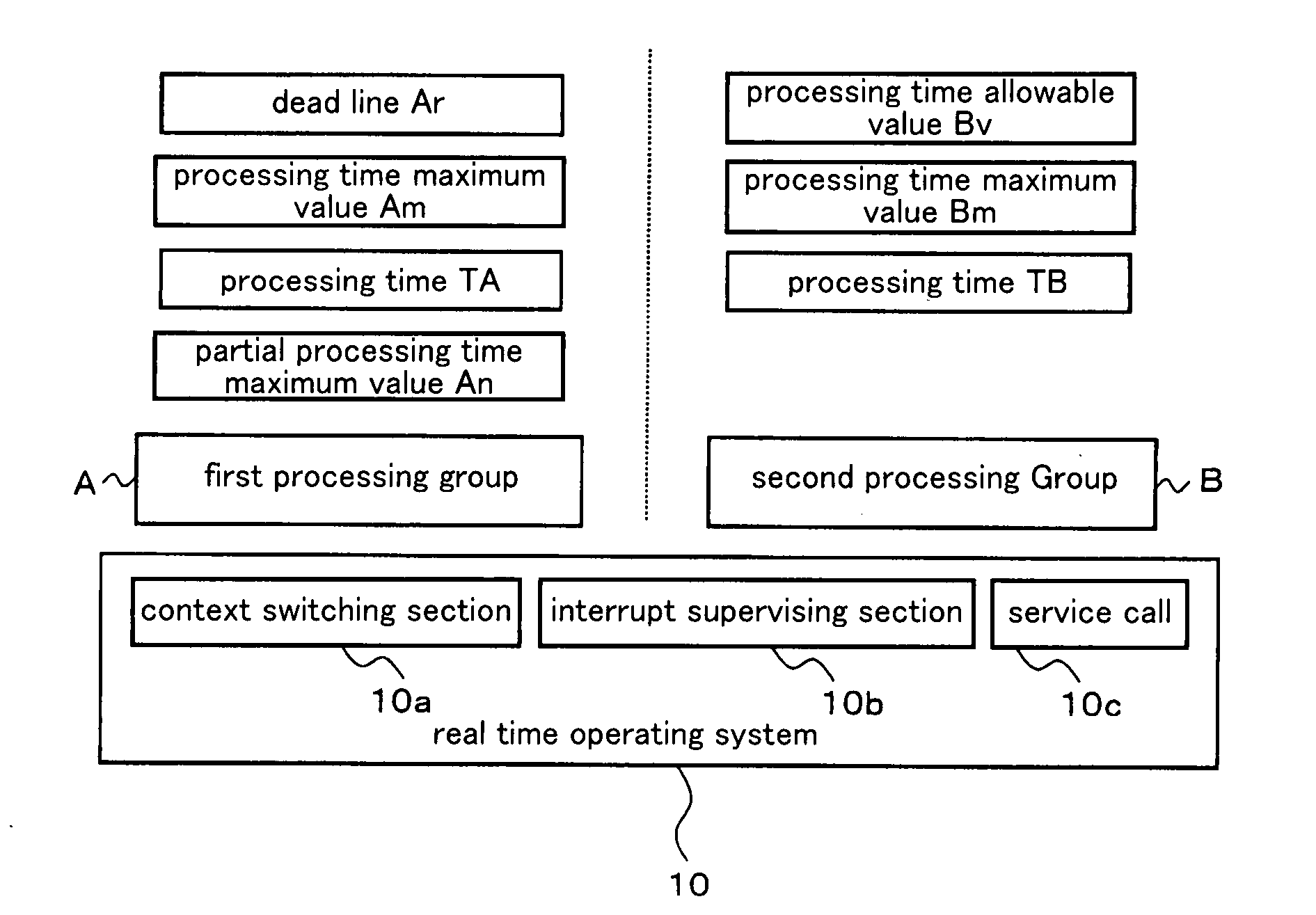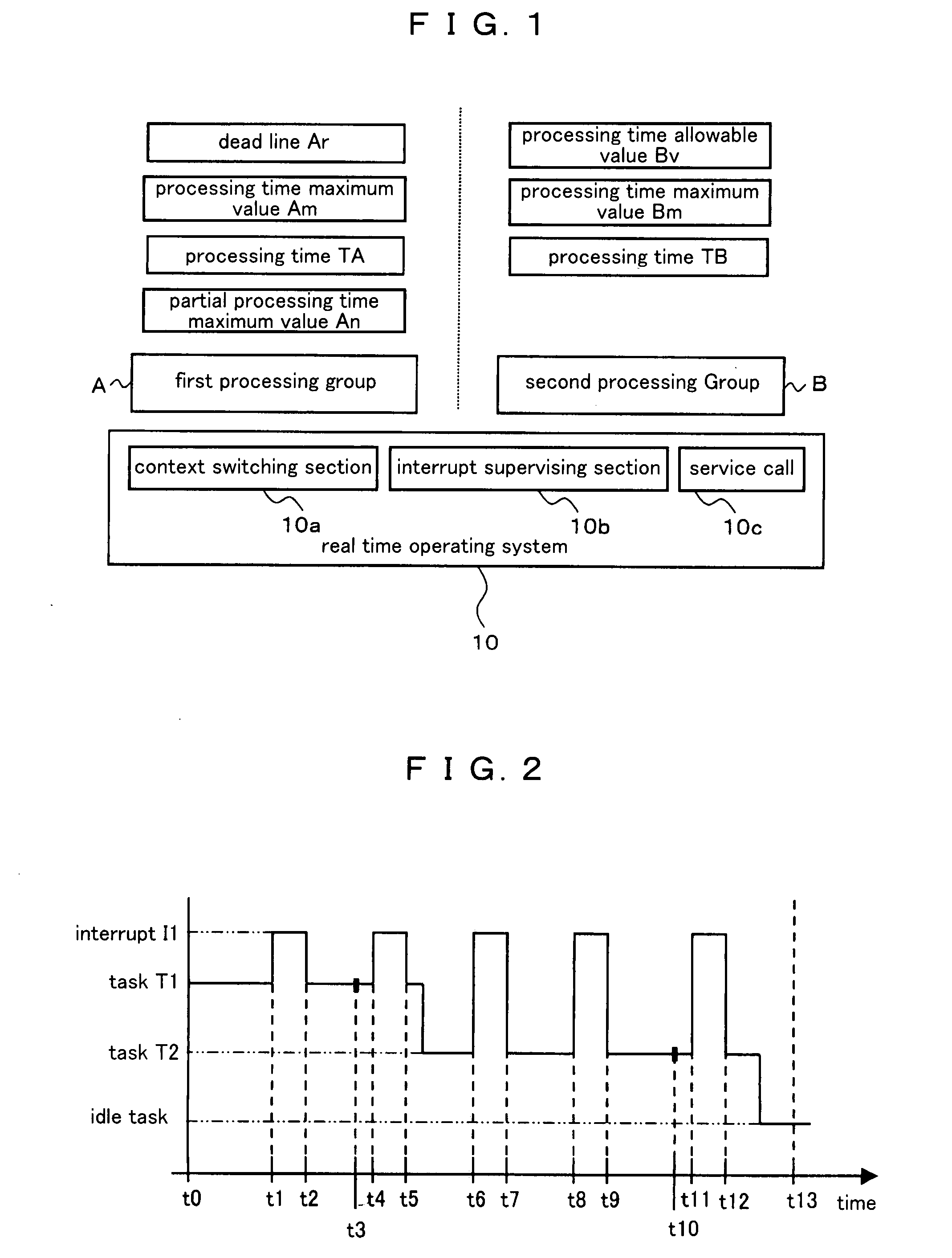Method of processing time distribution in real time operating system
a real-time operating system and processing time technology, applied in the field of real-time operating system processing time distribution, can solve the problems of increasing complexity of software, poor processing efficiency, and increasing software complexity, and achieve the effect of efficient execution of dead-line-free processing
- Summary
- Abstract
- Description
- Claims
- Application Information
AI Technical Summary
Benefits of technology
Problems solved by technology
Method used
Image
Examples
embodiment 1
Preferred Embodiment 1
[0046]FIG. 1 shows a system configuration of a method for distributing processing time in a real time operating system according to a preferred embodiment 1 of the present invention. In the configuration according to the present preferred embodiment, a first processing group A having a dead line leading up to completion of the processing and a second processing group B without any dead line leading up to completion of the processing are operated on a real time operating system 10.
[0047]The first processing group A supervises:[0048]dead line Ar set previously as a maximum tolerance value of time necessary for processing of the first processing group A to be completed;[0049]maximum value of the processing time necessary from start-up to completion of the processing of the first processing group A[0050]processing time TA from the start-up of the processing of the first processing group A; and[0051]maximum value of a partial processing time that is a maximum value ...
embodiment 2
Preferred Embodiment 2
[0076]In the preferred embodiment 1, the time difference between the dead line Ar and the processing time maximum value Am (Ar−Am) of the first processing group A is set as the processing time allowable value Bv of the second processing group B. On the contrary, in a preferred embodiment 2 of the present invention, “processable number of times”, that is calculated from the time difference (Ar−Am), is set as a processing time allowable value Bc of the second processing group B.
[0077]FIG. 3 shows a system configuration of a method for distributing a processing time in a real time operating system according to the preferred embodiment 2. In the configuration according to the present preferred embodiment, a first processing group A having a dead line leading up to completion of the processing and a second processing group B without any dead line leading up to completion of the processing are operated on a real time operating system 10.
[0078]The first processing gro...
embodiment 3
Preferred Embodiment 3
[0093]In the case of the preferred embodiment 2 wherein the processable number of times described above is used as the processing time allowable value, the actual processing time may be shorter than the processing time maximum value depending on a system, for example, in a cache system. More specifically, even though the second processing group B is made to be in the interrupt-allowable state again after the second processing group B is implemented as many times as the processing time allowable value Bc that is previously calculated, the dead line Ar of the first processing group A may be guaranteed. Such a situation is generated when the processable number of times is used as a judgment reference. More specifically, such a situation may be generated because a remainder is possibly generated when the processable number of times is calculated in the formula of (Ar−Am)÷Bm.
[0094]In a preferred embodiment 3 of the present invention, therefore, it is judged whether ...
PUM
 Login to View More
Login to View More Abstract
Description
Claims
Application Information
 Login to View More
Login to View More - R&D
- Intellectual Property
- Life Sciences
- Materials
- Tech Scout
- Unparalleled Data Quality
- Higher Quality Content
- 60% Fewer Hallucinations
Browse by: Latest US Patents, China's latest patents, Technical Efficacy Thesaurus, Application Domain, Technology Topic, Popular Technical Reports.
© 2025 PatSnap. All rights reserved.Legal|Privacy policy|Modern Slavery Act Transparency Statement|Sitemap|About US| Contact US: help@patsnap.com



